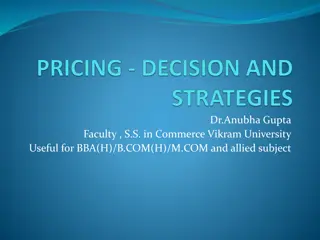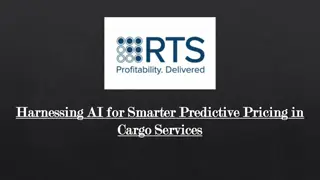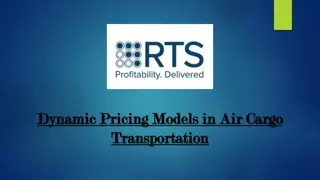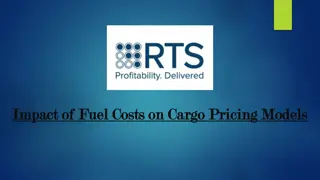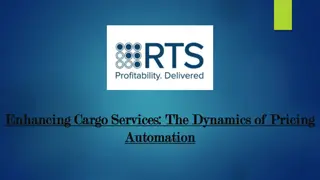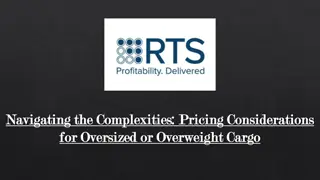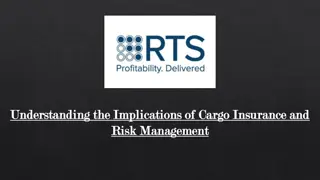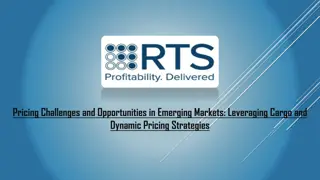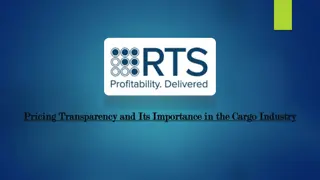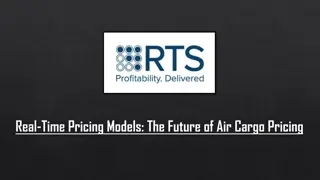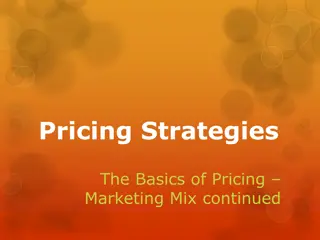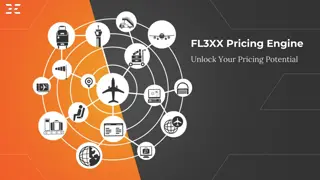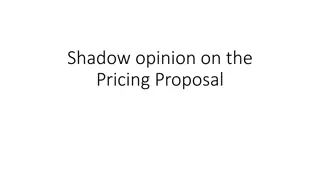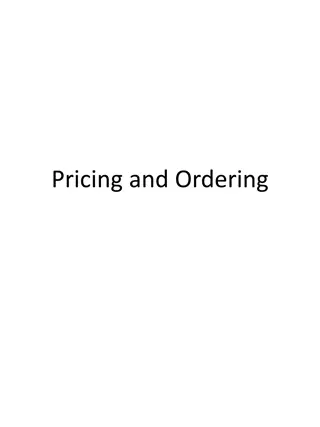Understanding Pricing in Business: Strategies and Challenges
Explore the role of pricing in business innovation, starting with the source of innovative design. Learn how pricing is influenced by various steps in the design thinking process and how to price appropriately by understanding your target market and stakeholders. Discover tools and strategies to navigate pricing challenges effectively.
Download Presentation

Please find below an Image/Link to download the presentation.
The content on the website is provided AS IS for your information and personal use only. It may not be sold, licensed, or shared on other websites without obtaining consent from the author. Download presentation by click this link. If you encounter any issues during the download, it is possible that the publisher has removed the file from their server.
E N D
Presentation Transcript
Pricing seems simple Walmart: $0.25. Whole foods: $0.50. Vending machine: $1 Bar: $2. Hotel: $3 Airport: $5. Bonaroo: $8 Taylor Swift Concert: $6,230
Introduction What are your goals for today? What pricing challenges do you face today?
Understanding pricing Discuss pricing and its importance in business Discuss the role of in pricing decisions in the innovation process
Understanding pricing starts with the source of your innovative design Feasibility Can we do it? What will it take? Innovation Desirability Do people want it? Will they pay for it? Viability Is it financially feasible? How do we get it to market? Source: Change by Design, Tim Brown
Pricing is influenced by every step in the design thinking process Ideation Experimentation Empathy Pillars Share story (and get it to market) Make ideas tangible Design element Test to learn Gather inspiration Generate ideas Frame question Piloting and testing Pyramid Principle Brainstorming Benchmarking Hypothesis generation Minimum viable products Process mapping Issue trees Market segmentation Customer ecosystem Empathy maps Interviewing for insights Tools Source: IDEO.org, Design Thinking, The Lean Startup
To price appropriately, you need to know your target market Total Available Market Served Available Market Target Market
and the influence of other stakeholders in the decision/buying process Tool: Consider all players in the customer ecosystem The Influencer Saboteur You, LLC. You, LLC. User User Recommender Decision Maker Super Duper One of a Kind Product / Service Payer
Tool: Empathy maps help build customer archetypes of behavior and environment You have to know your customer archetype and what creates value Source: Business Model Generation
You have to know your competitors This slide can show the advantage of the product/service, but can also show its shortfalls in comparison with similar products Metric derived from interview/ research Metric derived from interview/ research Metric derived from interview/ research Metric derived from interview/ research Product/ service Competitor 2 Competitor 3 The metrics for comparison should represent the factors that make or break the purchase of the product
You have to know your product or service Determining the Value Chain How would it work? How is the good, service, tech, delivered? How does the money flow? What partners are involved and how?
The business model canvas provides a frame to understand your offering Harvard Business Review
You should know the details of how your product is delivered operationally. Building 1 5 Pharmacy Diagnostics Check in Doctor s Evaluation 1 2 3 4 Counseling & X-ray Cervical Care Room Phase I: HPV Phase II: See & Treat 10 Cervical Care 1 practitioner working under doctor s license Vaccination training 200 vaccines/day 5 Swazi practitioners & 1 nurse 9 month training 300 screenings/day 8 Wound Care Pre/Post Operation Minor Surgical 6 7 9 Eye Care Building 2 Building 3
And you should know the financial implications of the offering Sells Buttons to transmission users Exclusive license Manufacturing and sales End users like academia 10 Buttons for $50 (1288% markup) $10K licensing fee + 6% royalty on revenue Best fit manufacturers Accreditation requirements Pre-licensing requirements File full utility patent application Manufacturers may apply for ASTM and ANSI requirements Fit criteria Complete accuracy and precision tests End users re-verify the device Must control a portion of the sampling prep market Experience licensing and developing with universities
You should know the type of revenue source Common revenue stream types Asset sale Know your customer segment: How does this customer segment typically buy? Who are the intermediaries (distributors, insurance companies)? What are the associated distribution costs? What will benefit your business (amount vs timing)? Usage fee Subscription Lend/ rent/ lease Licensing Brokerage Advertising Grants
Before you using three types of pricing methods Know baseline profitability for negotiating with distributors, bulk orders, etc. Cost plus Understand what customers currently are willing to pay for similar product/ service Competitive basis Calculate benefit gained by a customer from using your product/ service Value add
Those methods could be optimized with a different strategy Specific strategies to optimize your return Examples a small business that sells handmade products may adjust its pricing based on the price range of similar products sold by competitors at local craft fairs. Market-based pricing a retailer may price a product at $9.99 instead of $10.00 to make it seem like a better value to customers. Psychological pricing an airline may adjust ticket prices based on demand, with higher prices during peak travel times and lower prices during slower periods. Dynamic pricing Premium pricing a high-end jewelry brand may set a high price for its diamond necklaces to convey their exceptional quality and craftsmanship. Penetration pricing For example, a new smartphone manufacturer may set a low price to gain market share and attract customers away from established competitors.
..and pricing tactics could be selected to further maximize profits Tactics Examples Bundling and unbundling a software company may bundle several products together to offer customers a discount, or unbundle features from a premium product to create a more affordable version. Discounting a clothing retailer may offer a 20% discount during a holiday sale to incentivize customers to make purchases. Price skimming a technology company may introduce a new product at a high price and gradually lower the price as competitors enter the market. offering a range of car models at different price points, such as an economy line, a mid-range line, and a luxury line. Price lining A restaurant displaying an expensive, high-end dish on the menu to make other menu items seem like a better value. Price anchoring Price discrimination A movie theater offering discounted tickets for seniors or students
Testing your pricing plan can vary from more research to real world tests Testing strategies to get your plan Conduct surveys Price Sensitivity Meter (PSM) Price Rating Scales Gabor Granger pricing studies Conjoint analysis A/B testing "Everybody has a plan until they get punched in the mouth -Mike Tyson Market research Trial and error
Common pricing mistakes to avoid Underpricing or overpricing Failing to consider the competition Failing to consider the value proposition Failing to adjust prices over time Failing to communicate pricing decisions effectively
Conclusion Pricing requires deep knowledge of your product, market, the target customers, the broader ecosystem, and the competition There is no silver bullet to choose the best price, the market will tell you There are many pricing tactics you could use to optimize your return
References for more learning Books: "Priceless: The Myth of Fair Value (and How to Take Advantage of It)" by William Poundstone "The Strategy and Tactics of Pricing: A Guide to Profitable Decision Making" by Thomas Nagle and John Hogan "Value-Based Pricing: Drive Sales and Boost Your Bottom Line by Creating, Communicating and Capturing Customer Value" by Harry Macdivitt and Mike Wilkinson "Pricing for Profit: How to Develop a Powerful Pricing Strategy for Your Business" by Peter Hill Online resources: Harvard Business Review - "The Right Way to Manage Unprofitable Customers" by Andreas Hinterhuber and Stephan Liozu McKinsey & Company - "The Power of Pricing" by Georg Winkler, Scott Keller, and Jim Lattin Forbes - "The Top 6 Pricing Strategies for Small Businesses" by Hootan Shahidi


